
A Guide to Commercial Patio Umbrellas
As outdoor dining continues to grow as an appealing option for customers, patio space is an asset like never before. Guests love indulging in your crisp salads and colorful entrees as they take in the fresh air and atmosphere of your outdoor space. Your patio needs to be comfortable and protected from weather and the elements, which is why patio umbrellas are an absolute must during the summer season. In order to make your patio space as profitable as possible, even in hot weather, use outdoor umbrellas to curate a cool, relaxing, and shady spot for your customers.
Shop All Patio Umbrellas
Anatomy of a Commercial Patio Umbrella
When you're in the market for an outdoor patio umbrella, it's important to identify the parts of the umbrella that distinguish it from a hand-held umbrella. The right patio umbrella will become your new favorite piece of outdoor furniture.
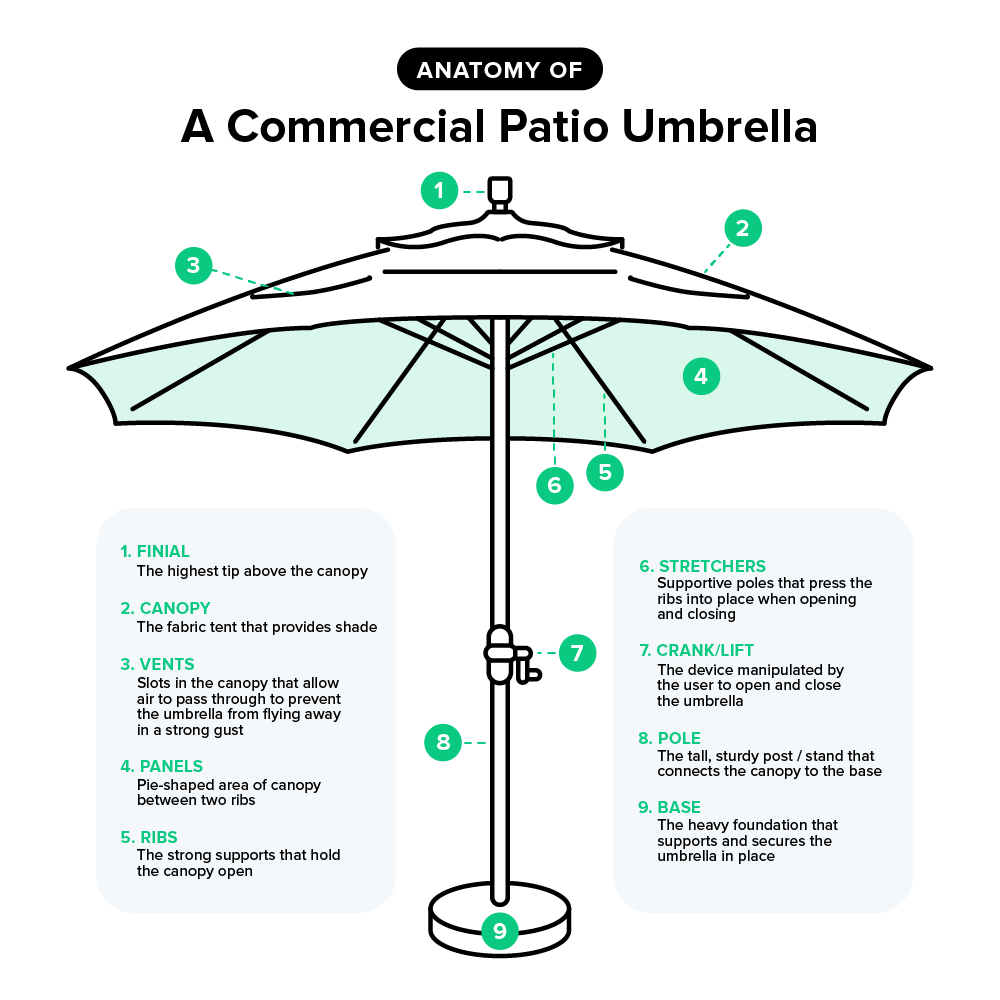
- 1. Finial: The highest tip above the canopy
- 2. Canopy: The fabric tent that provides shade
- 3. Vents: Slots in the canopy that allow air to pass through to prevent the umbrella from flying away in a strong gust
- 4. Panels: Pie-shaped area of canopy between two ribs
- 5. Ribs: The strong supports that hold the canopy open
- 6. Stretchers: The strong supports that hold the canopy open
- 7. Crank/Lift: The strong supports that hold the canopy open
- 8. Pole: The tall, sturdy post/stand that connects the canopy to the base
- 9. Base: The heavy foundation that supports and secures the umbrella in place
Outdoor Umbrella Canopy Materials
Heavy-duty fabric is the preferred material for the canopy of commercial patio umbrellas. Fabrics give slightly so as not to tear and break under the elements, come in a variety of colors and patterns, and serve as a protective barrier between the intense sun and your guests. Consider that thicker fabrics will offer more protection but will cause the ribs and stretchers to work harder to support the weight.


- Lightweight and durable
- Very resistant to UV rays and color-fade
- Combats mold and mildew growth
- Scratchy texture
- Can be much more expensive
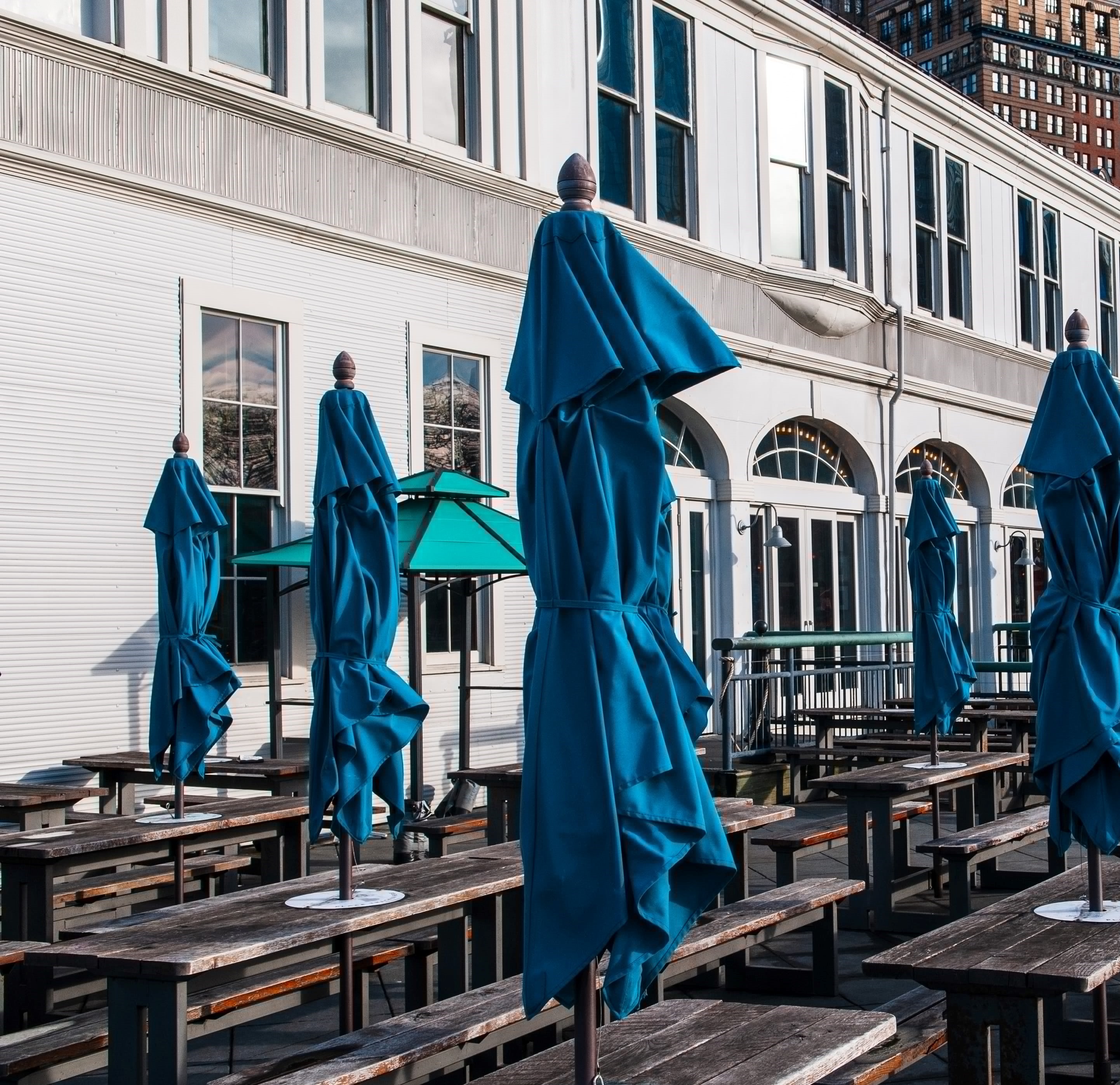

- Typically inexpensive
- Naturally water-repellent
- Very lightweight
- Not UV-protected unless specifically marketed as such
- Usually not as durable and doesn't last as long
- More difficult to keep clean


- Durable and long-lasting
- Water- and mildew-resistant
- Easy to keep clean
- Less resistant to fading and UV rays
- Can be damaged by friction and high heat
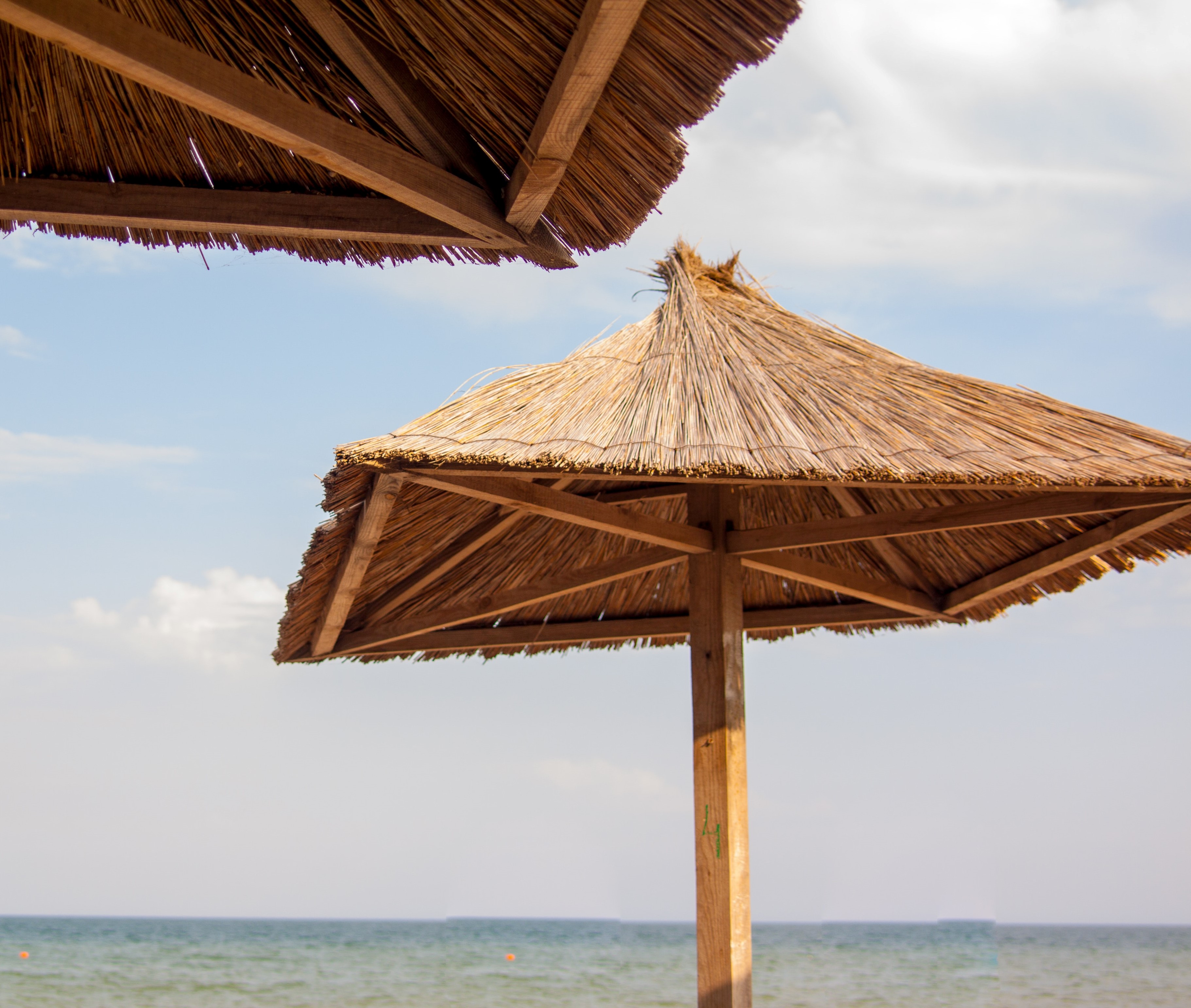

- Creates great ventilation
- Rot- and fade-resistant
- Attractive and festive appearance
- Not durable against the elements
- Difficult to maintain and clean
What to Look for in a Patio Umbrella Base
Some umbrellas are sold with their base already included as a kit, but many are not. The base is a vital part of the umbrella, as it stabilizes the pole and secures it in place under windy and inclement conditions. There are a variety of shapes and designs to choose from, but your biggest considerations should be the weight and material of your umbrella base.

Commercial Umbrella Base Weight
The weight needed to secure your umbrella safely in place will depend upon the size of your umbrella canopy. You may choose a heavier base if you’re operating in a location known for high winds and violent weather.
- 40 lb. - 50 lb. Weight: A 40 lb. - 50 lb. base is all that will be required for umbrellas with diameters between 5 feet and 8 ½ feet. These umbrellas are small and require less weight to counterbalance the canopy.
- 55 lb. - 70 lb. Weight: Bases that weigh between 55 lb. – 70 lb. are considered sufficient for medium-sized umbrellas. You can safely secure an umbrella with a diameter between 9 feet and 10 feet with this base.
- 100 lb.+ Weight: These bases are meant for the largest commercial umbrellas. Any umbrella with a diameter larger than 10 feet should be secured with a 100+ lb. base. This also may be the best choice for patio umbrellas located in geographic regions known for high winds and stormy weather.

Some commercial umbrella bases come with wheels attached for increased maneuverability.
Commercial Umbrella Base Material
The base of your umbrella is going to face quite a bit of wear and tear, from puddles, to UV rays, to everyday grime.

Cast Iron
- Cast iron fits well in a high-end environment. It comes in a variety of designs and the weight comes from the iron itself, so you won’t need to fill it with sand or gravel to keep it in place.
- It's a good idea to invest in a powder coating to prevent rust in high humidity.
- The notable downside of a cast iron base is that it is incredibly difficult to relocate around your patio. While it isn’t impossible to move, it’s certainly not an easy task.

Resin
- Resin is a great choice if you think you would like to relocate your patio umbrellas. If you like to redesign and remodel from time to time, resin umbrella bases will give you the freedom to do just that.
- Heavy-duty resin won’t rust, flake, or crack.
- Resin itself is very lightweight, the downside of which is that it can be a laborious process to fill the base with water, which runs the risk of freezing and cracking from the inside if left outside during the winter, or gravel, which can get messy.

Steel
- Steel bases are sturdy, strong, and resist denting and damage.
- Galvanized or stainless steels are better options for outdoor furniture because they resist rust and are long-lasting when exposed to the elements.
- Untreated steel bases are prone to rusting just like cast iron. A rusting base can leave unsightly marks on your patio that are difficult or even impossible to clean, so it’s important to powder-coat your steel base to prevent such deterioration with time.

For an eco-friendly option, choose a base made of recycled resin. Recycled resin is strong and requires little maintenance. Many types are made of recycled plastic milk jugs and containers.
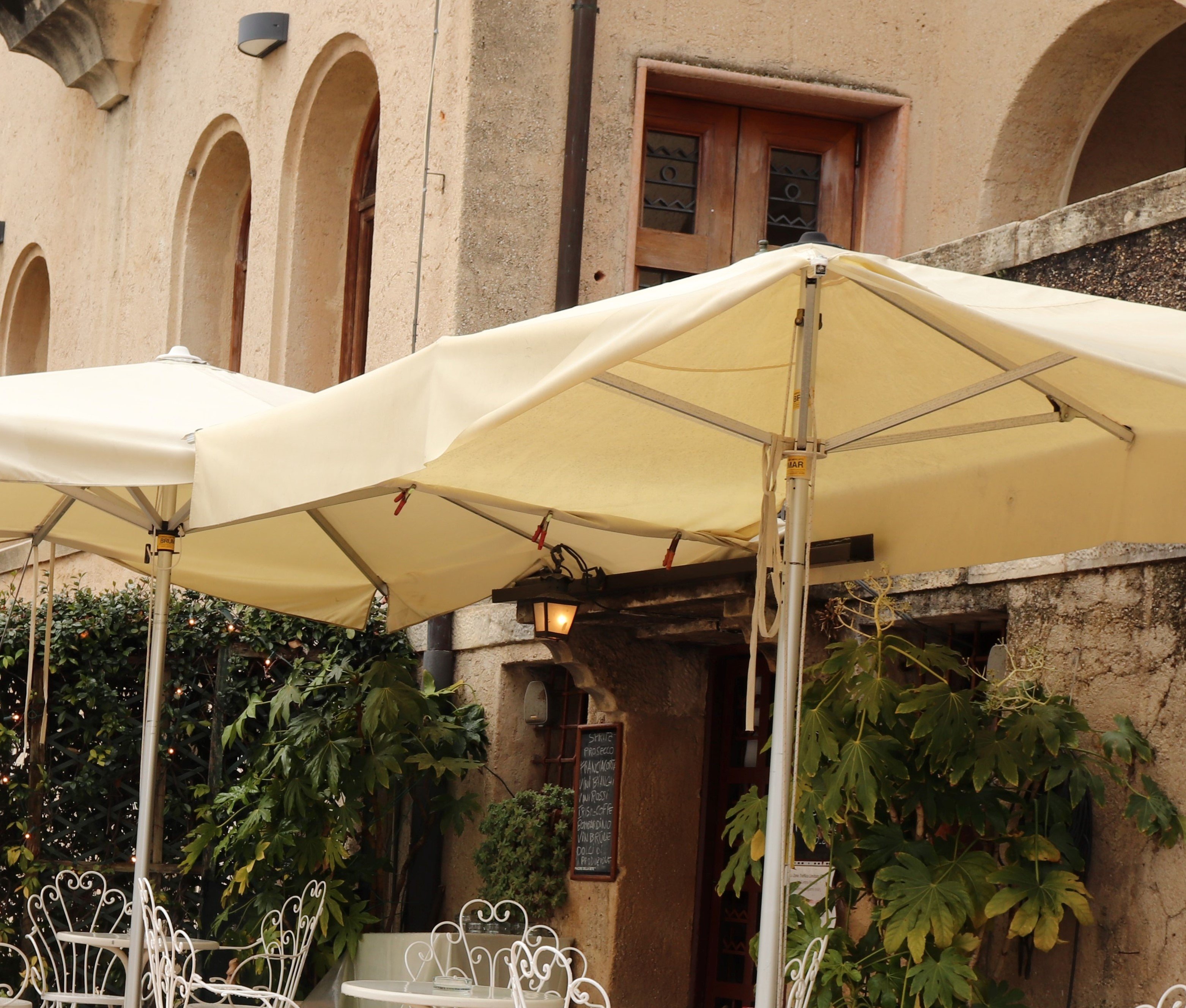
Choose the Material for a Patio Umbrella Pole
Umbrella pole material can be an overlooked facet of the umbrella. Still, the pole will take quite a beating after months and years of raising and lowering the umbrella canopy. It's important to find a pole that can handle the pressures of the elements and long-term use.
Aluminum
Can handle hazardous weather without buckling or breaking.
- Lightweight and low-maintenance
- Resistant to wear and breakage
- Considered the most popular material for outdoor furniture
- Does not promote a high-end look
Increased flexibility and durability. Great for very windy environments.
- Bends in the wind without breaking
- Highly durable and dependable
- Resists rot and mildew
- Typically much more expensive
A cost-effective option.
- Resistant to UV rays
- Will not corrode, mildew, or rust
- Comes in decorative varieties and colors
- Tends to show dirt the most; scratched areas collect grime
Great for upscale settings such as hotels or resorts.
- Natural, classic appearance
- Some varieties (such as teak) are naturally water- and rot-resistant
- Requires proper sealing
- Can fade and wear if untreated

Some umbrella poles have a hinged design so you can tilt the entire canopy in the direction of the sun throughout the day.
The Lift on Your Outdoor Patio Umbrella
Freestanding patio umbrellas are the perfect choice for restaurants and cafes that need versatility and mobility. They come in a variety of lift types to match your needs.

Cantilever
Since they come with their own base, cantilever umbrellas are easy to relocate. They provide more usable shade, as the pole is located on the outer edge of the canopy.
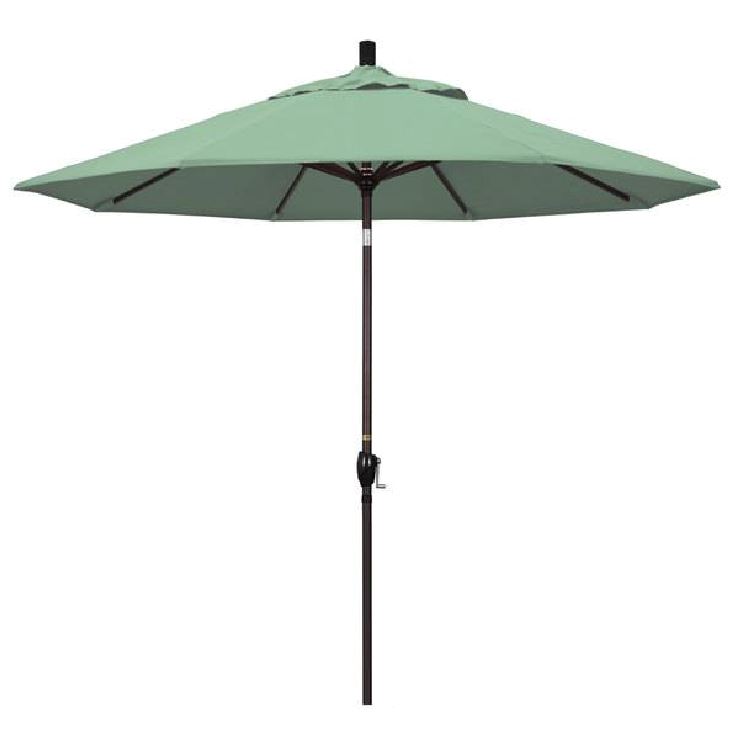
Crank
Ideal for large and heavy umbrellas, crank lift umbrellas open and close by rotating a crank handle.

Pulley Lift
Also requiring minimal physical effort, pulley lift umbrellas open easily using a rope and wheel system.

Push Lift
Though they are simple to operate, push lift umbrellas require the most physical effort. They can lock into place with a pin.
Outdoor Umbrella Sizes for Your Space
You need to consider how much shade you’d really like for your patio, and how the sun will change direction and intensity through the day.
- Do you want heavy shade across the entirety of your space?
- Would you like partial shade during the morning and heavy shade in the afternoon?
- How will the temperature affect how much shade your patrons need during daylight hours?
Perhaps you want to have one umbrella for each table on your patio. You should be asking, "what size table can my umbrella accommodate? How much shade will my umbrella make? Will it cover this table and all of the chairs around it?" Use the comprehensive chart below to determine what size umbrella you need to cover the desired size of tables and chairs on your patio. Or, you can choose to shade a large area rather than separate tables. In that case, you should be asking "how many umbrellas do I need to shade my patio space?" With the information in the table and a little simple math, you can choose the correct number of umbrellas for your square footage.
Example Situation: "I want to buy 6 1/2 ft. umbrellas to shade as much of my 500 sq. ft. patio as possible. How many umbrellas should I buy?" 500 sq. ft / 40 sq. ft. = about 12 umbrellas for full shade
Canopy Diameter | Table and Chairs Shaded | Approximate Area of Shade Produced |
|---|---|---|
6 ft. - 6 1/2 ft. | 30" table or smaller 2 - 4 chairs | Up to 40 sq. ft. |
7 1/2 ft. - 8 ft. | 36" - 40" table 4 - 6 chairs | Up to 50 sq. ft. |
9 ft. - 10 ft. | 40" - 48" table 6 - 8 chairs | Up to 75 sq. ft. |
11 ft. | 48" table and larger 10 - 12 chairs | Up to 95 sq. ft. |
Personalizing Your Commercial Umbrella and Patio Space
Patio umbrellas serve both as a functional shade producer and a decorative accent! Given the variety of commercial umbrellas on the market, there's no need to choose an umbrella that doesn't contribute to the personality of your space.
Appearance
The colors, shapes, and styles of your patio umbrellas will contribute to the look of your outdoor space.
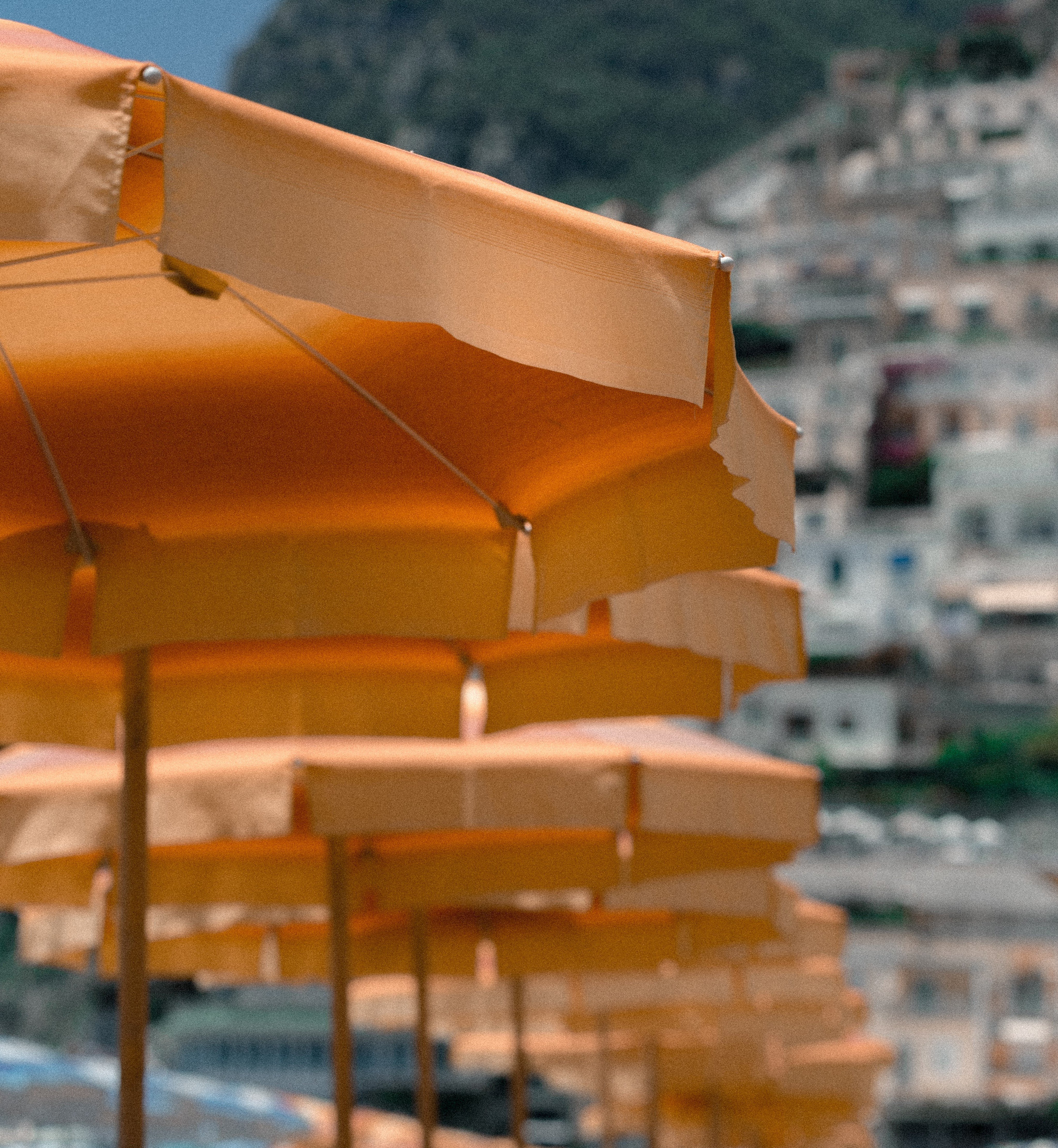
Consistent Styles and Colors
- Keeps your patio looking cohesive and classy
- More convenient for your staff to raise and lower daily
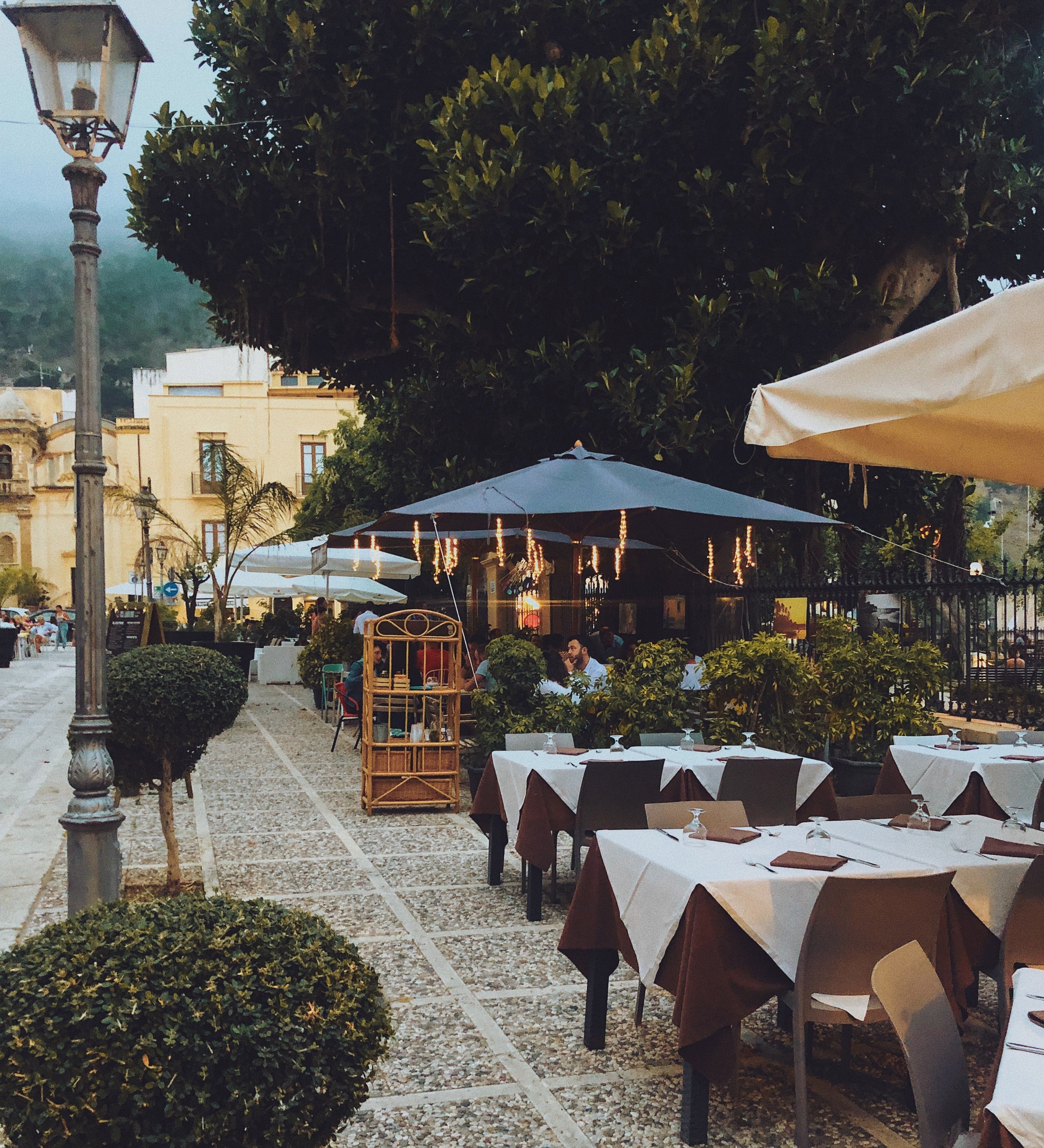
Mix-and-Match
- Creates a fun, lighthearted atmosphere for your patio
- Only choose two or three eye-catching colors, prints, or shapes
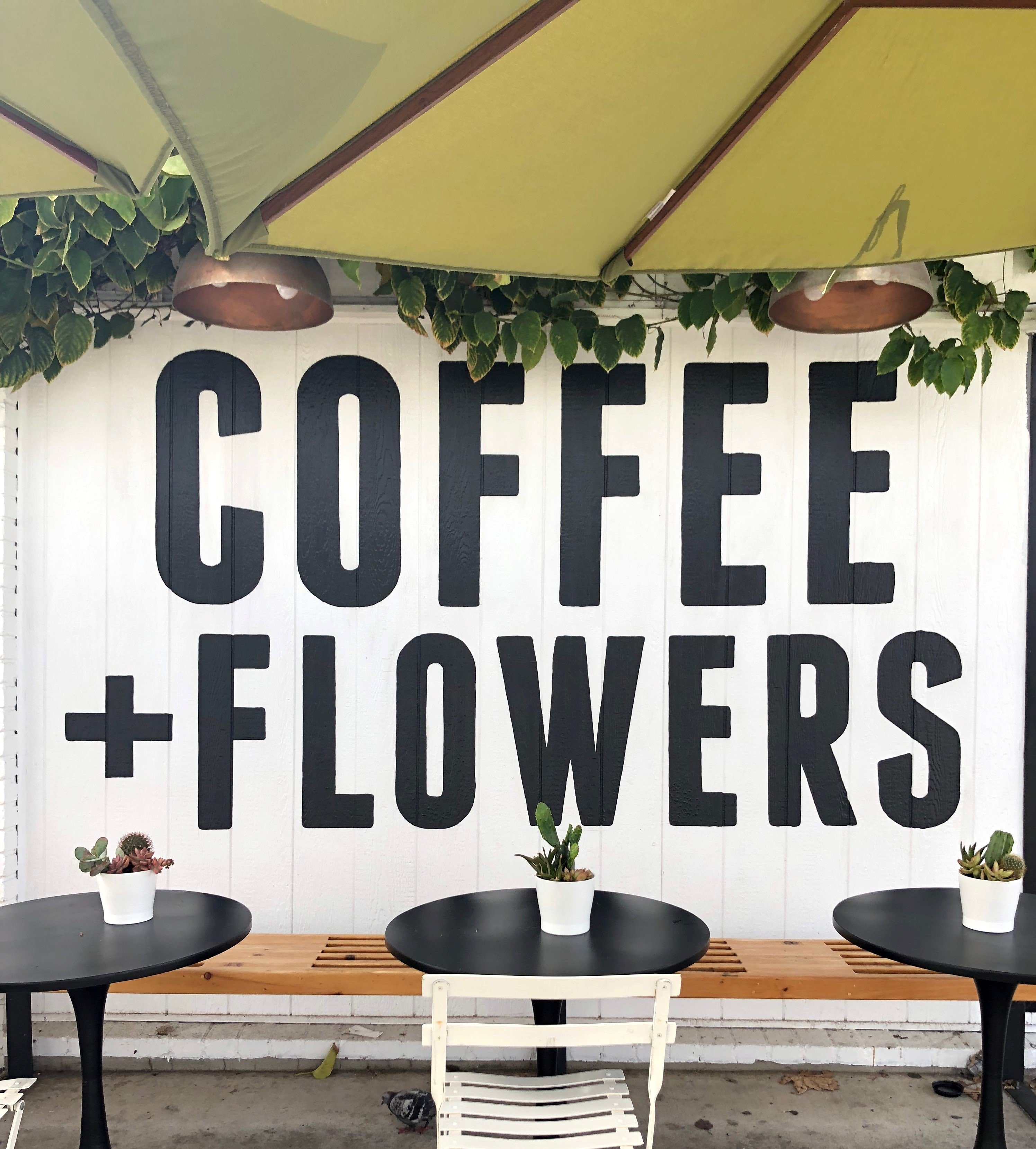
Curate a "Vibe"
- Extends interior theme and style to outdoor space
- Similar decorations, colors, and text presents an intentional style
Staying Cool
Pair your umbrellas with a few additional cool tools in your outdoor space to keep the heat at bay!
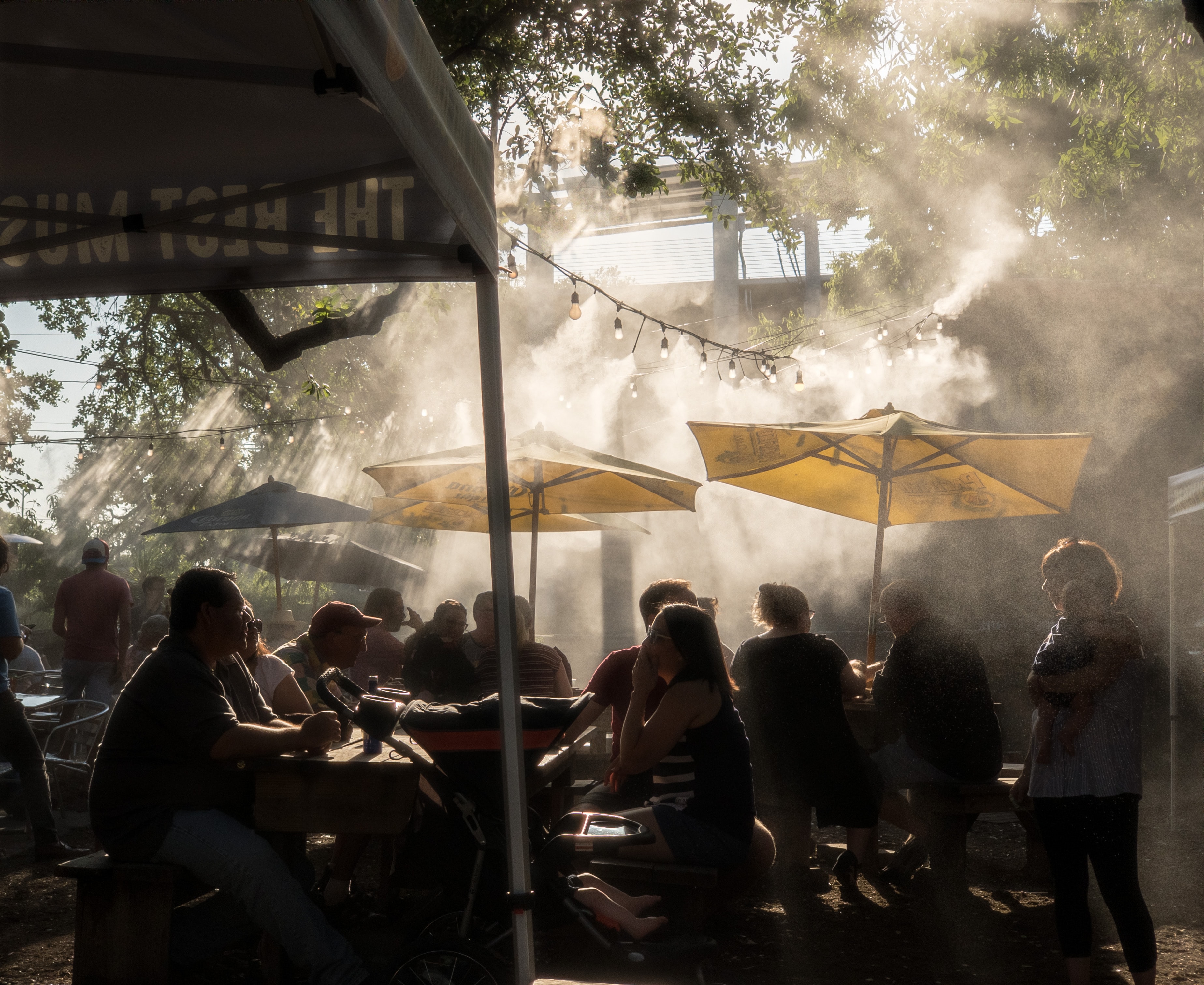
Fans and Misters
- Mounting large fans save space while keeping the patio cool
- Choose fans with a low operating volume
- Add patio misters for additional cooling effects

Tall Shade Plants
- Areas without plants are hotter than areas with plants
- Plants with large leaves reflect sunlight away and provide shade
- Consider adding leafy shade trees or large shrubs to your patio
Accessories
Treat your umbrella as a decorative furniture piece that can be spiced up to match your own unique ambiance. For your consideration:

- Twinkle Lights: There’s no reason to close your umbrellas at night when you have twinkle lights! These lights add a gentle glow as the sun starts to set and look fantastic draped along the ribs of the umbrella right under the canopy. There are even solar-powered options to help you impress your eco-minded guests.
- Pole Tray Attachment: Use the pole of your umbrella to hold napkins, condiments, and even utensils with a tray attachment. A tray is an easy way to keep table items collected and sanitary, and saves table space for your guests’ drinks, appetizers, and entree dishes.
- Extra Weights: Do you operate in an extra-windy or stormy geographic region? Consider investing in extra weights for your patio umbrella to keep it grounded and secure under the elements.
- Bug Net: Swarms of mosquitos and gnats are perhaps the biggest challenge to outdoor dining, and you certainly don’t want to use harsh chemicals to keep bugs at bay while you’re serving your signature dishes. Try a hanging bug net! There are nets specifically marketed for use with umbrellas; their lightweight nature makes them safe to attach along the edges of the canopy and reach all the way to the floor to keep bugs away from the table.
How to Care for Your Outdoor Restaurant Umbrella
Keeping your umbrella clean and cared for is the most important step to ensuring longevity. Follow these comprehensive steps at least once a week, if possible, to protect your investment.
- Close the umbrella and brush off dirt and spider webs with a soft-bristle brush.
- Make a solution with warm water and mild soap and spray it all over the canopy with a spray bottle. Use the soft-bristle brush to gently scrub.
- Open the umbrella to clean the inside of the canopy in the same way.
- Close the umbrella again and spray it down thoroughly with a hose (make sure there is absolutely no soap residue left).
- Allow the canopy to dry in the sun in an open position.
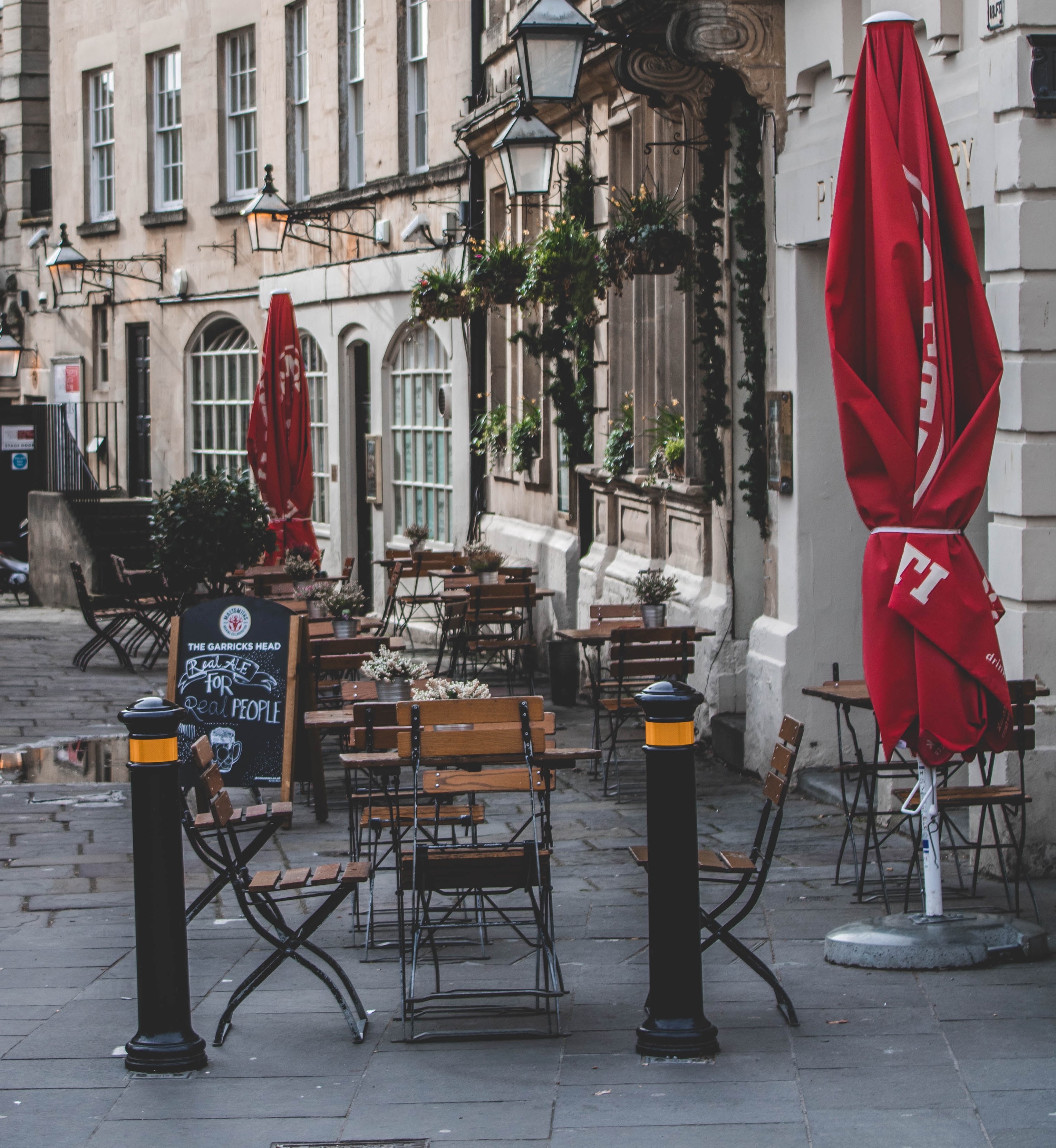
Additional Umbrella Care Tips
- If your canopy appears to be fading in color, use a UV-protection spray. Since UV rays are damaging to fabrics, applying a protective barrier in the form of an inexpensive spray will keep your canopy looking brighter, longer.
- Always keep your umbrella canopy closed when it’s not in use.
- If you won’t be utilizing your patio space (for example, during the winter months) always relocate your umbrella to a dark, dry place in your storage room to protect it from water and weather.
- Consider investing in a high-quality umbrella cover. An umbrella jacket will protect your investment against wear and tear, rain, snow, and sun. It also keeps the canopy tightly compact to prevent damage during high winds.
Related Resources

Winter Outdoor Dining Ideas for Restaurants
When winter arrives in a flurry of snow and cold temperatures, many restaurant owners transition from outdoor dining and focus on creating enticing seasonal menus and deciding whether to stay open during the holidays instead. However, don't abandon your outdoor dining area until spring. Winter outdoor dining advancements offer bars and restaurants options to overcome the seasonal slowdown and increase sales. Use our winter patio ideas to convert your outdoor dining space into a magical winter wonderland, complete with heaters, exclusive menu offerings, and charming rustic decor. Shop All Outdoor Restaurant Furniture Winter Patio Ideas for Restaurants Most restaurant operators prepare their restaurants for winter by closing up their patios.
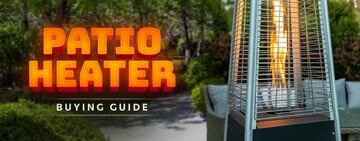
Different Types of Patio Heaters
If you have an outdoor seating area, you know just how profitable those spaces are! Customers love eating outdoors where they can enjoy good food, fresh air, and vibrant city views or sweeping rural vistas. By using commercial patio heaters to increase the number of days your patio is open every year, you'll increase the profitability of your outdoor spaces which in turn will boost your bottom line. Shop All Commercal Patio Heaters Use the following links to explore outdoor heating options, so you can make a more informed purchase for your outdoor space! Outdoor Heater Options Gas vs Electric Outdoor Heaters Benefits of Outside Patio Heaters What to Look For in an Outdoor Heater How to Design a Patio Heating System Outdoor Heater Safety Out

Pest-Free Outdoor Dining
No matter what type of restaurant you operate, pests are a nuisance that need addressed. When you take the correct steps, pest control is easily managed and secures the success of your business. Not only do pests endanger your establishment by potentially carrying harmful bacteria and diseases, but they also annoy customers and can drive them away. As a result, understanding how to deal with outdoor pests and avoid attracting them altogether is key to hosting a successful outdoor dining experience. Shop All Pest Control Supplies Outdoor Dining Outdoor dining has become one of the most prominent trends in the restaurant industry. Beer gardens and other outdoor dining options became popular for restaurant owners and diners in 2020. However, t
- Topics 1346
- Industrial 55
- Troubleshooting Guides 21
- Restaurant Management 128
- Bar Management 55
- Catering Tips 35
- Bakery Management 42
- Food Trucks & Concessions 49
- Advertising & Marketing 37
- Eco-Friendly Tips 11
- Facility Layout & Design 41
- Coffee Shop Tips 28
- Installation & Maintenance 51
- Janitorial & Pest Control 30
- Safety & Sanitation 88
- Startup Tips 104
- Menu Design 10
- Kitchen & Cooking Tips 81
- Hospitality Management 23
- Pizza & Sandwich Shop Tips 36
- Smallwares 37
- Food Prep 88
- Tabletop Items 17
- Disposables 22
- Calculators & Tools 6
- Consumables 52
- Warewashing & Laundry 18
- Cooking Equipment 90
- Food Storage & Refrigeration 51
- Beverage Equipment 34
- Office Supplies 6
- Resource Type
- In-Depth Articles272
- Buying Guides296
- How-Tos93
- Product Reviews77


